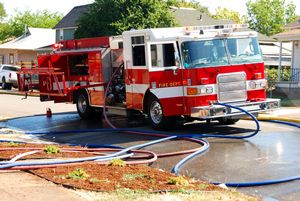|
By accessing or using The Crittenden Automotive Library™/CarsAndRacingStuff.com, you signify your agreement with the Terms of Use on our Legal Information page. Our Privacy Policy is also available there. |

Different Types of Firefighter Vehicles
|
|---|
|
|
Different Types of Firefighter Vehicles
Red Truck Fire and Safety Company
19 June 2017
A fire truck or the fire engine is a vehicle specifically designed to fight small to large scale fires. Fire engines are also used for a myriad of other operations including hazmat, EMS, technical rescue or auto extrication.
The main role of the fire engine is to transport firefighters and provide water as well as a full range of equipment a firefighter might need.
According to Red Truck Fire and Safety Company, fires can range from Class A to Class D, with the former being caused by ordinary combustible materials like wood or paper, and the latter being caused by dangerous combustible metals like sodium or magnesium.
A regular fire truck is equipped to handle a wide range of rescue and firefighting tasks, including managing all the different classes of fires. However, a lot of fire trucks are adapted to fit a specific area.
Here is a brief overview of different firefighter vehicle types.
Conventional Fire Engine

|
The conventional fire engine is the one you are most likely to see out on the streets. Their main feature is a pump that shoots water out of the reservoir or tank located at the back of the truck. It allows the engine to shoot water when there are no fire hydrants nearby.
However, since they are limited to 500 to 1500 gallons of water, they can only work for a limited period of time. Most commonly, fire engines can shoot water for 4 to 15 minutes, depending on the capacity.
Fire engines in big cities are usually equipped with smaller tanks for two reasons. The first one is that a fire hydrant is almost always nearby in a densely-populated, urban area. The second is so that the engine could easily maneuver through narrow streets.
Turntable and Tower Ladder Trucks
Fire trucks and ladder trucks are often confused. Simply put, a fire truck is not always equipped with a ladder. Since these units are often expensive, not every fire company owns one of these.
The most common special apparatus fire engine, this truck is used to access high fires thanks to a large, extendable ladder.
A variation of this truck has a basket mounted on top of the ladder. These engines are commonly referred to as tower ladders. They provide a safe place from where a firefighter can operate the firefighting equipment.
These trucks do not have a tank to supply water but connect to a hydrant instead. Their main purpose is rescuing victims or firefighters trapped inside a burning building. Therefore, these units are fitted with equipment such as axes, pike poles, Halligan bars and hydraulic spreaders and cutters.
Brush Units
These units are used to reach areas large trucks cannot, like forests or remote areas through difficult terrain. They are equipped with a smaller reservoir that can carry from 50 to 300 gallons of water. They also use smaller hoses and pump the water at a lower pressure since the units are often closer to the fire in the forest.
These trucks can also be used for non-emergency medical assistance and small-scale fires, which can be put out with an extinguisher.
Airport Crash Engine
This specific type of fire engine is used in airports to handle aircraft accidents. These fire trucks feature better acceleration, ability to traverse rough terrain around the runway and the airport, an increased water capacity, a high-capacity pump and a foam tank.
Command Support Engine
Due to the increased frequency of large-scale incidents, command support units were developed to help fire departments easier assess these threats. These units are equipped with an array of communication equipment needed to coordinate the firefighting efforts at major incidents.


















